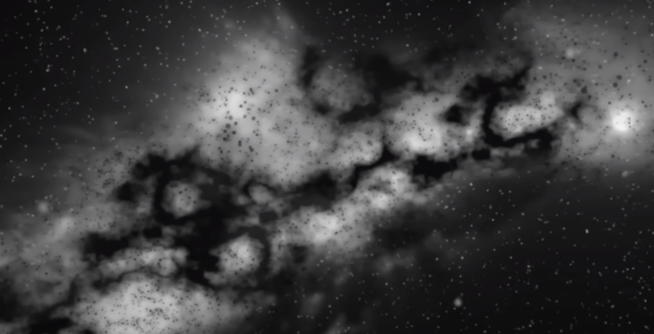The solar system is home to human beings, and the Milky Way is home to the solar system, so what kind of place is the edge of the Milky Way? The edge of the Milky Way, far away from us, is a very special place, surrounded by a huge halo of hot plasma, dotted with globular clusters, ancient stars, and possibly even the remnants of a ghost galaxy that predates the Milky Way.
As we explore more and more, the mysteries of our galaxy are growing, and one astrophysicist recently proposed research that suggests a mysterious, unknown force is tearing holes in our galaxy. What the hell is going on?
Scientists further investigated the cause of these disruptions, which are called cosmic bullet holes, or things like being knocked around causing holes in the Milky Way, so how do scientists identify holes in the Milky Way? There's a surprising anomaly in the uniform stream of stars in the extragalactic halo, which has a strange kink caused by closure that looks like a cosmic fist passing through the tides and dragging stars along, according to research by Anna Banaka of the Harvard-Smithsonian Center for Astrophysics.
Arrangement is known as the star of the stars in the stream, the star line as a group with a single gap across the galaxy. Galaxies should draw a straight line in the sky, however, there is a huge star stream hole, seems to be a powerful force impact, due to the impact force and uneven, making the stars lose the orderly arrangement. The galaxy where the hole is located is GD1, a globular cluster and the remnants of a group of older stars with a mass 70, 000 times the mass of the sun that was destroyed by gravitational interactions with the Milky Way in the past. Fortunately, though, this mysterious force is so far away that the solar system is safe for now.
According to the inspection of nagorno-karabakh, something seems to be the new hole was pierced, first of all, they can determine the quality of the impactor is larger than any stars in the Milky Way, and the quality of millions of times larger than the mass of the sun, scientists suspect impactor and the known of the Milky Way's black hole, it is unlikely to be a star, the experts also we got a conclusion according to the comparison, The jagged black holes in GD1 lack the characteristic flares or radiation that other black holes exhibit. If it were a black hole, it would be a supermassive black hole, but if it were a black hole, it would show features completely inconsistent with a black hole 39bet-đua chó-game giải trí -đá gà-đá gà trực tuyến-đánh bài.
After ruling out stars and black holes, scientists believe the likely force piercing this galaxy is dark matter, the invisible component that holds galaxies together and accounts for about 25 percent of the matter and energy in the universe. Gravity holds the universe together. We know how it works, but we're not sure of its actual nature. In fact, the mass in the form of stars, dust and gas must be about 27 percent more than we can perceive because it can't be detected. It's called dark matter, but we haven't been able to determine its composition. It's one of the greatest mysteries of all time.
 However, the unusual observation has scientists wondering about the existence of dark matter, even though the theory is far from proven. But dark matter is probably the best explanation. Dark matter doesn't reflect any light, it's almost invisible, it just creates gravity, and in this case, it could have cosmic effects. The stuff piercing the galaxy, for example, is made of this mysterious stuff, but how can scientists prove it's dark matter? It's a subversive theory, after all!
However, the unusual observation has scientists wondering about the existence of dark matter, even though the theory is far from proven. But dark matter is probably the best explanation. Dark matter doesn't reflect any light, it's almost invisible, it just creates gravity, and in this case, it could have cosmic effects. The stuff piercing the galaxy, for example, is made of this mysterious stuff, but how can scientists prove it's dark matter? It's a subversive theory, after all!
According to the current theories about how the universe formed, it consists of ordinary matter, such as a galaxy of astrophysical object around the bracket assembly may have tens of thousands of small dark matter groups gathered around and within the Milky Way. These small clusters are often referred to as dark matter halos, they are total darkness, and no star. Although it can't be measured directly, scientists can provide indirect evidence of dark matter by observing the movement of gas or dust from stars in galaxies. Therefore, researchers must create new ways to study subhalos that don't contain any regular matter, for example, if dark matter can exist in galaxies.
If researchers can get the conclusion that it will be a change in the physical rule discovery, because the smallest mass of dark matter and has not yet been determined is closely related to the mass of dark matter, dark matter is made up of particles, more specifically, the quality of the particles increases with the size of the dark matter clumps, then pierced the Milky Way is dark? If scientists find this to be the case, it will be very surprising, because it may give us more information about dark matter. Of course, this is just a guess of dark matter, whether dark matter exists or not needs more direct evidence.